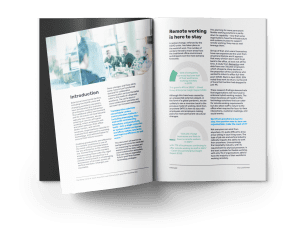By Ian Thomas, Operations Director
This blog post summarises our webinar on The Importance of Engagement in a Covid World, which you can watch here.
Covid-19 has fundamentally changed our working practices, and the effects will be felt not only during the pandemic, but long after the vaccines have been rolled out.
When the pandemic hit, everyone who could work from home was asked to do so. Service Desks, Contact Centres and various other departments were spun up from a multitude of remote locations, or as we would call them, home.
Those who could not work from home entered Covid-secure offices, with one-way systems, desk booking platforms, masks worn around the office and a significant reduction in the number of people on site at any one time.
These changes have resulted in colleagues who are now geographically spread, isolated from each other, and relying on cloud and collaboration technologies to work together.
With many organisations continuing to operate remote or hybrid working models as lockdown restrictions lift, business leaders must ponder an important question. How can we continue to keep our teams engaged when our working and personal lives have been thrown up in the air?
What is employee engagement?
Firstly, it’s important to define the scope of what we’re talking about here. According to the voluntary movement, Engage for Success, employee engagement is:
“…a workplace approach, resulting in the right conditions for all members of an organisation to give up their best each day, committed to their organisation’s goals and values, motivated to contribute to organisational success with an enhanced sense of their own wellbeing.
“It is based on trust, integrity and two-way commitment and communication between an organisation and its members.”
What are the benefits of engagement?
The obvious benefits of an engaged workforce are that employees remain informed, motivated and productive, contributing to their organisation’s success.
Engagement is also the key to maintaining employee wellbeing. Whilst not everyone suffers from mental health issues, all of us have mental health. And focusing on positive employee wellbeing has been proven to:
- Lower absences
- Enable higher productivity
- Reduce turnover
- Improve working relationships
- Strengthen the overarching capacity of an organisation
- Enhance an organisation’s reputation as a place that people want to work for
For these reasons, employee engagement should be a priority for all business leaders – and not just during global pandemics or times of crisis. It should be a permanent consideration.
How can you get the best from your dispersed workforce?
After the initial excitement of working differently has died down, how do you keep up the high levels of engagement? Well, there are various things you can do:
Recognise the changes
It’s important you acknowledge that everyone’s home “office” is different – studies, spare rooms, dining room tables, breakfast bars, even caravans and sheds have now become the new base locations for colleagues. Add to this the complexity of their households. Are they on their own or part of a busy home? Are their hours of work now different to cater for their changes in routine?
Understand that with a diverse workforce, a one-size-fits-all approach to engagement won’t work. Instead of adopting one way of doing things, consider a multifaceted approach to enable the same message to consistently land.
Review your existing engagement activities
Consider which activities are more effective, given your new working practices.
In the traditional office setting, you had a captive audience at events, where the majority of messages would be listened to and absorbed, and you could hold colleagues’ attention.
Virtual approaches are very different. Colleagues have constant and regular distractions, and we now have to compete with those. Think about virtual town halls that bring everyone together and smaller group events, such as coffee mornings and topical chats.
Prepare for the unexpected
You’ve probably experienced this in the form of dogs barking, children photobombing and delivery drivers knocking at doors.
But also, don’t be surprised if people working remotely open up quicker and more often than you might have anticipated. How you deal with these moments carries weight and impact.
Prepare for the line blur
The mixing of environments, home and work, may result in some colleagues being unable to separate the two. Some may be more relaxed in their conversation and humour, while others may find it difficult to determine where the start and the end of the day should be.
When planning engagement activities, you should be conscious of these new behaviours and try to promote a work/life balance.
Seek feedback
Don’t be afraid to ask people for their thoughts and suggestions.
Every one of us is adapting to new working practices, and that includes those leading the organisation. We might not get it right every time, but by regularly garnering opinion and asking what could work better, our colleagues will help us shape our new ways of working together.
What are the key principles of employee engagement?
There are also some simple principles to remember when planning engagement activities, and these apply whether your workforce is fully remote, onsite or a mixture of the two.
Establish a regular drumbeat of communication
Planned, regularly distributed, endorsed communications from key stakeholders in the business will generate that sense of community and a singular purpose.
However, it’s equally important that you regularly review the relevance of these communications, making changes to ensure they continue to deliver impact.
Deliver consistent messaging
We must be consistent with our messages and ensure that they get to everyone who needs to hear them.
Leaving different functions to disseminate certain messages can have severe consequences when everyone is remote, with some colleagues brought up to speed quickly and others kept out of the loop.
Create a “one team” ethos
Exceptional service is only achieved when everyone is aligned and working towards a common goal for the benefit of the customer.
A team mantra and sense of collective identity make people feel like they’re pulling in the same direction, regardless of where they are.
Drive a culture of collaboration
A collaborative culture is key to employees feeling connected and engaged with their organisation. Silos often exist in organisations and can be exacerbated when people are working from home.
Key stakeholders should lead by example and show that sharing and supporting is the right way forward. You could also enable colleagues to recognise collaborative behaviour when they see it through a reward and recognition programme.
Bring all colleagues together
Although it’s not always easy logistically, holding regular virtual community sessions, town halls, or conferences can be really powerful. They allow key messages to be driven home, as well as underlining that single, shared objective that we all strive for within our organisations.
Promote inside and out
Many colleagues won’t have any idea what other teams are doing – and they’ll have even less of an idea when working remotely. So tell them! Share the achievements of different teams to help build that “one team” ethos and collaborative approach.
Make engagement your priority
Whilst Covid-19 has changed the way we work, live and behave, engagement remains a constant and one of the key activities your organisation needs to get right.
Covid-19 has meant we’ve had to change the ways we deliver engagement activities, but it hasn’t diminished their importance. Employee engagement is intrinsically linked to workforce wellbeing, collaboration, and productivity – ensuring output benefits your business and customers.


For more detailed research and insights into the future of work, download our report:
The Rising Trend of ‘Work Anywhere’ and How to Future-Proof Your Workforce
Download




